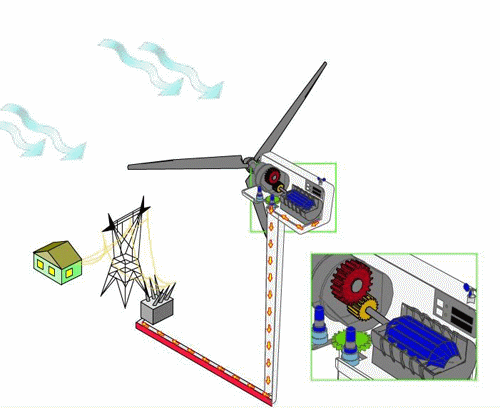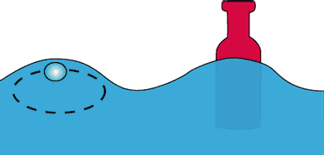Energy is derived from the Greek word for activity, to activate, operate or to work.
utility | voltage | current | calorie | force | Watts | fields | etymology | resistance | energie | electrical | timing | history of electricity | lesson
![]()
"When we talk of energy we tend mostly to think of electricity; at first sight this might seem blinkered, but as we shall see it is sensible to rank electricity first."
James Lovelock (2006) p.68.
Energy became an important concept as natural philosophers began to measure heat, light, electricity, and magnetism during the 17th century in Europe based on older Arabic manuscripts that had become available since the Renaissance. By the 19th century with the perfection of steam engines in the previous century, interest in measuring the performance and efficiency of combustion engines contributed to emerging scientific subjects of thermodynamics, magnetism, and electrical forces.
"The greatest need modern civilizations have is energy."
"Energy Production," How stuff works.
"In 1821 Michael Faraday succeeded in producing mechanical motion by means of a permanent magnet and an electric current—an ancestor of the electric motor. Ten years later, in 1831, he converted magnetic force into electrical force, thus inventing the world’s first electrical generator. In the course of proving that electricities produced by various means are identical, Faraday discovered the two laws of electrochemistry: the amount of chemical change or decomposition is exactly proportional to the quantity of electricity that passes in solution; and the amounts of different substances deposited or dissolved by the same quantity of electricity are proportional to their chemical equivalent weights. In 1833 he and the classicist William Whewell worked out a new nomenclature for electrochemical phenomena based on Greek words, which is more or less still in use today—ion, electrode, and so" the words we have today.
magnetism | energy | power | utility | volts & voltage | force | flow | coulomb | ampere | calorie | electricity | diagram | time | resistance | summary | lesson
"Electricity and magnetism are relatively new sciences. . . . Allesandro Volta . . . put forward the idea of a new physical concept, the electric current, that is electrical charges in motion."
J. Andrade e Silva & G. Lucian, Quanta, (1969), pp. 24-26.
"
To emphasize my contention that a continuous supply of electricity is an essential requisite for civilization, what follows is a brief account of our personal experience with a supply failure on a local scale caused by bad weather."
"la petit mort"
"It seemed perfectly to express my deep sense of dismay and loss that the failure of electricity always brings. How could my friend so fear electricity when I was distraught without it?
"Like it or not, I was surely, along with nearly everyone, mainlining on alternating current and had been for nearly all my life."
"Electric power is extraordinary in the way it insinuates itself dendritically throughout society. The wires that carry it extend to every home like nerves in our bodies. It is always there at a wonderfully constant level, yet hardly anyone of the millions who work in the industry worldwide ha has more than the vaguest notion of what it is or how it is made and regulated."
"The electricity system exists as a communal, but almost wholly unconscious, activity. No wonder we took it for granted; at least we did until it stopped."
James Lovelock, The Revenge of Gaia. pp. 69-71.
What do these terms: power, energy, force, electricity and motion really mean?
Peak power Power – or electrical current – generated by a utility referring to a unit that operates at a very low capacity factor; the highest output or capacity is generally used to meet short-lived and variable high demand periods. |
|
|---|---|
Utility-interactive
A power system which interacts with the utility grid ( called mains the grid refers to the totality of the wires, substations, and transformers that distribute electrical current from a generating plant to the places electricity is consumed ), taking power from the grid to satisfy its load -- or the aggregate demands of all customers-- as necessary, and returning power to the grid when not required by the loads.
An example of wind generated electricity. |
 |
Electrical generating facility uses water turned into steam by burning coal, with a cooling tower to restore the ambient temperature to the hot water. Electricity and water are the two Gameli (Roman twins), or Bobsie twins of modern industrial energy because you cannot have one without the other. Water is heated into steam, hot steam turns a turbine that drives a rotating electromagnet in a changing magnetic field. This process induces a current of electrons from the field and disperses the electrons along a conductor or wire. |
|
utility | voltage | current | calorie | force | Watts | fields | etymology | resistance | energie | electrical | timing | history of electricity
![]()
"Increasing the voltage will make more current flow."
Measured in volts (V), the electrical potential between two points. One volt of potential causes one ampere of current to flow through a resistance of one ohm. The open-circuit voltage of a silicon solar cell is about half a volt; the operating voltage of a lead-acid cell (of a battery) is about two volts.
Volts, force (mass times velocity squared) of potential power; the pressure available due to the volume of electrical potential, volt ( V )
the current is equal to the voltage divided by the resistance.
I = V/r
Ampere, flow, or rate of movement of the electrical charge; measured as the electrical current equal to a flow of one coulomb per second. Amp ( I )
Just as a current of water is measured in gallons per second, so we could measure an electric current in electrons per second. But the electron has such a tiny charge that enormous numbers of them are needed to make even a small current. For example, a pressure of one volt pumps 6.25 billion billion electrons per second through a resistance of 1ohm. A current of this size is known as an ampere. A current of a little less than 1 ampere flows through a common 100 watt light bulb. The total electric charge of 6.25 billion billion electrons is called one coulomb (koo-lowm). An ampere is also defined as a current that carries a charge of one coulomb per second.
Calorie is the measure of the amount of energy required to raise the temperature of a gram of water by 1 degree Celsius (centigrade). A gram of water is about enough fluid to fill a thimble sized container.
Coulomb, charge, electric charge, equal to the quantity of electricity conveyed in one second by a current of one ampere.
Erg is a unit of work or energy, equal to the work done by a force of one dyne when its point of application moves one centimeter in the direction of action of the force.
Force, the strength of an effect in any action on objects; the push or the pull-- hence the repulsion from or the attraction to one object by another.
utility | voltage | current | calorie | fields | energie | electrical | timing
Watts, the rate of the draw, or excrescences of energy, hence a measure of power or capability; power produced or consumed or the rate at which force is used to do work; measured as equal to one Joule [J] per second.
The human being can produce about 100 watts of power, on average when exerting movement in say walking or deep knee bends.
Electrical power is measured in watts. In an electrical system power (P) is equal to the voltage multiplied by the current. P = VI.
kilowatts, one thousand watts or Kw for kilowatts;; 1000w or the measure of power equal to ten human bodies.
Magnetic and electrical fields are inversely related to one another but coexist in a dimension that was mathematically explained by James Clerk Maxwell's equations. The fields oscillate over time as they move through space. Electromagnetism is a force (one of three fundamental universal forces) that suggests that spacetime are one entity that we sense –nonetheless– as two separate existences.
http://science.howstuffworks.com/question501.htm/image
Hertz, frequency of the oscillation; equal to one cycle per second.
Ohm, resistance or friction; measured as the resistance in a circuit transmitting a current of one ampere when subjected to a potential difference of one volt. (Symbol: Ω)
second of time 
ORIGIN late Middle English : from medieval Latin secunda (minuta) 'second (minute),' feminine (used as a noun) of secund us, referring to the “second” operation of dividing an hour by sixty.
utility | voltage | current | calorie | fields | energie | electrical | timing
![]()
Energy is matter in motion. In any real sense energy is the measure of movement (but what moves?); the change in the state of something over time with respect to the motion of its molecules, or its position with respect to some identifiable background is how energy is measured.
Arranged from less to more with regard to the amount of energy electromagnetic waves exhibit.
Some experts say "energy is the ability to do work," but that suggests the power to overcome a force, in our case the universal or fundamental force of gravity. We exert energy to overcome the forces of gravity or wind, or a magnet pulling metal objects away from our grasp.
Energy = En + Erg inherent activity or the ability to move and a capacity for such movement, That is why energy is said to exist in two forms. Those forms are potential (inherent ability) and kinetic (actual expression of the capacity). The origin of the word is from the mid 16th century (denoting force or vigor of expression): from French énergie, or via late Latin from Greek energeia, from en- ‘in, within’ + ergon ‘work’.
Energy is elusive in the sense that some people call it stuff, the very stuff Einstein said was equivalent to any mass moving at the speed of light squared.
Work, even "to work within" seems a very far removed concept from the idea of matter moving at 186,000 miles per second.
Intangible as it may seem in definitions, energy is essential to all movement unintentional or intentional and energy is –in abstraction– something that can never be created nor destroyed. Energy is, as the first law of thermodynamics suggests, always conserved [Law of mass-energy conservation].
Richard Wolfson, Energy, Environment, and Climate. New York: W. W. Norton, 2008. pp. 1-3, 22-37.
utility | voltage | current | calorie | fields | energie | electrical | timing
![]()
Electricity
This is a force that arises from the atomic spaces that we cannot see, yet we --of course we experience-- and what exactly electromagnetism is eluded scientists for years until Michael Faraday and others such as his mentor Humphry Davy, began to unravel the mysterious power of a substance that flows like, but differently from water and carries with it a magnetic field of attraction such that some authorities suggest that the electron is accompanied by a magnetic field – or force area around which similarly charged particles are deflected.
"What are amps, watts, volts and ohms?." 31 October 2000. HowStuffWorks.com. <http://science.howstuffworks.com/question501.htm> 21 May 2008..
go to How stuff works, web site .
Electricity, etymology of the word:
1640s, first used in English by physician Sir Thomas Browne (1605-1682), apparently coined as Modern Latin: electricus (lit. "resembling amber") by English physicist William Gilbert (1540-1603) in treatise "De Magnete" (1600), from L. electrum "amber," from Greek; elektron "amber" (Homer, Hesiod, Herodotus), also "pale gold" (a compound of 1 part silver to 4 of gold); of unknown origin. Originally the word described substances which, like amber, attract other substances when rubbed. Commonly used to refer to the electromagnetic force.

Time and timing.  |
||
|---|---|---|
 |
is the highest level reached by the wave. | |
| Crest | ||
| Amplitude is a distance a wave falls from above to below its crest through its trough to rise up again. | ||
| Trough | ||
| is the lowest level of the wave. | ||
Duration & frequency are related.
Time is a critical element in understanding electricity. Without an instrument that could reliably record seconds, the capacity to comprehend electrical charge would be impeded.
duration refers to the extent of existence or continuation over a period that something persists; hence endures.
frequency refers to how often, or how rare an event occurs; infrequent is rare, while quite often is called frequent. The elapsed duration between troughs or between crests of a wave is its frequency.
![]()
Humphry Davy's reputation was made by his book Researches, Chemical and Philosophical, chiefly concerning Nitrous Oxide . . . and its Respiration (1799).
His recommendation that nitrous oxide (laughing gas) be employed as an anesthetic in minor surgical operations was ignored, but breathing it became the highlight of contemporary social gatherings. In 1801 Davy was appointed—first as a lecturer, then as a professor of chemistry—to the Royal Institution in London, which he molded into a center for advanced research and for polished demonstration lectures delivered to audiences largely made up of fashionable gentlemen and ladies.
Among his many accomplishments, Davy discovered several new elements. In 1807 he electrolyzed slightly damp fused potash and then soda—substances that had previously resisted decomposition and hence were thought by some to be elements—and isolated potassium and sodium. He went on to analyze the alkaline earths, isolating magnesium, calcium, strontium, and barium. Davy's recognition that the alkalis and alkaline earths were all oxides challenged Lavoisier's theory that oxygen was the principle of acidity. Later, Davy determined that not all acids contain oxygen—including muriatic acid (our hydrochloric acid), which, as Davy discovered, was not "oxymuriatic acid," as Lavoisier thought. It contained only hydrogen and one other element—chlorine.
Davy had an assistant, after 1813, named Michael Faraday:
 Michael Faraday, the discoverer of electromagnetic induction, electromagnetic rotations, the magneto-optical effect, diamagnetism, field theory and much else besides, was born in Newington Butts (the area of London now known as the Elephant and Castle) on 22 September 1791.
Michael Faraday, the discoverer of electromagnetic induction, electromagnetic rotations, the magneto-optical effect, diamagnetism, field theory and much else besides, was born in Newington Butts (the area of London now known as the Elephant and Castle) on 22 September 1791.
See: http://www.bbc.co.uk/history/historic_figures/faraday_michael.shtml
Nearly ten years to the day after his discovery of electromagnetic rotations that Faraday was able to resume his work on electromagnetism, when he discovered on 29 August 1831, electromagnetic induction. This is the principle behind the electric transformer and generator. It was this discovery, more than any other, that allowed electricity to be turned, during the nineteenth century, from a scientific curiosity into a powerful technology.
During the remainder of the 1830s Faraday worked on further developing his ideas on electricity. He enunciated a new theory of electrochemical action between 1832 and 1834. Among the results of his experimentation was that he coined, with William Whewell, many of the words now so familiar – electrode, electrolyte, anode, cathode and ion to name but five. In the later half of the 1830s Faraday worked on a new theory of static electricity and electrical induction.
This work led him to reject the traditional theory that electricity was an imponderable fluid or fluids. Instead he proposed that electricity was a form of force that passed from particle to particle of matter. His practical work on electricity and magnetism allowed for the new power's application to the telegraph and electrical machinery that could generate an electrical current from a mechanical device.
utility | voltage | current | calorie | fields | energie | electrical | timing
magnetism | energy | power | utility | volts & voltage | force | flow | coulomb | ampere | calorie | electricity | diagram | time | resistance | summary | lesson

Lessons
Electricity is an elusive, yet very real substance that is also insubstantial with respect to bodies such as ours.
That is because humans generate electricity as well as conduct electrical current.
As Whitman suggested we are the body electric, in that each of us is as it were a candle (light) burning with 100 watts in the electromagnetic wind.
The earth so huge and the electron so humble are both electromagnets as if electricity were everywhere or at least imbued, although tightly hidden, in all things.

J. Andrade e Silva & G. Lochak, Quanta. New York: McGraw-Hill,1969. pp. 24-26.
James Lovelock. The Revenge of Gaia; Earth's Climate Crisis and the Fate of Humanity. New York: Basic Books, 2006. pp. 68, 69-71.
The devils in the wave's details.
See also: http://aaenvironment.com/Electricity.htm
Vocabulary | flow | power | current | measure | electricity's origin
magnetism | energy | power | utility | volts & voltage | force | flow | coulomb | ampere | calorie | electricity | diagram | time | resistance | summary | lesson
![]()
 |
||
|---|---|---|
| Tools of Toil: what to read. | ||
| Tools are historical building blocks of technology. | ||
Atoms | Bohr | Gell-Mann | Light quanta | Photons | Quantum biology | Quantum qualities | Quantum Universe | Radiation is